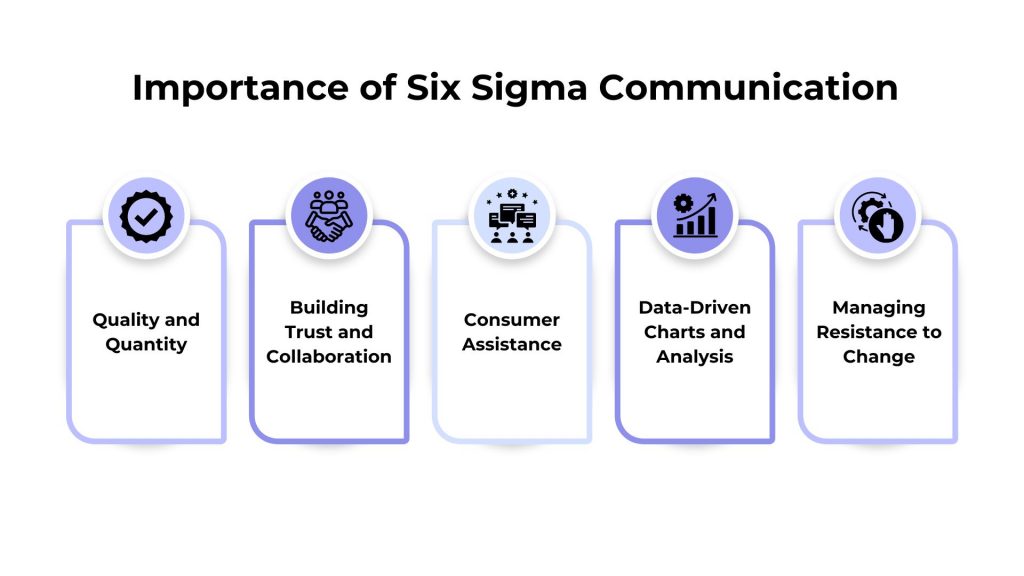
In the high-stakes game of Six Sigma, communication isn’t just important—it’s everything. In the complex world of Six Sigma, where precision, efficiency, and continuous improvement are crucial, clear and concise communication ensures that team members are aligned, goals are understood, and processes are seamlessly executed. It bridges the gap between different departments, enabling smooth information flow and fostering a culture of transparency and accountability.
This blog explores the critical role of Six Sigma communication, highlighting how it fosters collaboration, enhances problem-solving, and drives project success. By understanding the importance of effective communication, organizations can better utilize the power of Six Sigma methodologies to achieve operational excellence and significant business improvements. Let’s get started!
Table of Contents:
- Significance of Six Sigma Communication
- Quality and Quantity
- Building Trust and Collaboration
- Consumer Assistance
- Data-Driven Charts and Analysis
- Managing Resistance to Change
- Conclusion
Significance of Six Sigma Communication
Six Sigma communication is critical for the success and sustainability of Six Sigma initiatives within an organization. Effective communication ensures that everyone involved in the Six Sigma process understands its goals, methodologies, progress, and outcomes. Here are some key points highlighting the significance of Six Sigma communication:
1. Quality and Quantity
Effective Six Sigma communication is vital to ensure both the quality and quantity of information shared. High-quality communication involves providing accurate, relevant, and clear information, which reduces misunderstandings and enhances decision-making capabilities. It ensures that all team members have a clear understanding of the project objectives, methodologies, and their individual roles.
The right quantity of communication entails maintaining a balanced flow of information. This means regular updates, meetings, and status reports that keep everyone informed about the project’s progress, issues, and milestones without causing information overload. Such a balance helps team members stay aligned with project goals, fostering an effective working environment.
2. Building Trust and Collaboration
Transparent and honest communication within Six Sigma teams is essential for building trust and fostering collaboration. When team members feel they are receiving all necessary information and their contributions are acknowledged and valued, trust naturally develops. This trust leads to an open exchange of ideas, concerns, and solutions, which is critical for the problem-solving nature of Six Sigma projects.
Clear and consistent communication ensures that everyone understands their roles, the overall project goals, and how their work contributes to these objectives. This clarity promotes a collaborative atmosphere where team members are encouraged to share their insights and expertise, leading to more innovative solutions and efficient problem-solving.
3. Consumer Assistance
Communication within Six Sigma teams directly impacts their ability to address consumer needs and issues effectively. The team can focus on projects that significantly enhance customer satisfaction by sharing consumer feedback, data, and requirements. This process ensures that the voice of the customer (VOC) is continuously heard and integrated into decision-making processes, leading to improvements in products and services that meet or exceed consumer expectations.
Effective communication about consumer needs helps the team prioritize their efforts and their strategies to deliver the greatest value to customers, leading to increased customer loyalty and market success.
4. Data-Driven Charts and Analysis
Data-driven charts and analysis are at the foundation of Six Sigma projects, and effective communication ensures that all team members understand and utilize this data appropriately. By sharing visual tools like charts, graphs, and statistical analysis, complex information is accessible and understandable to all team members. This visualization helps identify trends and the impact of changes, making it easier to track progress and measure success.
Clear communication about data findings ensures that decisions are based on solid evidence rather than assumptions, which enhances the possibility of successful project outcomes. This data-centric approach also fosters a culture of continuous improvement, where insights from data drive ongoing enhancements.
5. Managing Resistance to Change
Managing resistance to change is a significant challenge in Six Sigma projects, and effective communication is key to overcoming it. Open and transparent communication allows team members to express their concerns, understand the benefits of the proposed changes, and feel involved in the change process. Addressing fears and uncertainties through clear and consistent messaging helps mitigate resistance by providing rational explanations and highlighting the advantages of the improvements.
This approach builds a case for change by clearly articulating the problems with the current state, the proposed solutions, and the expected benefits. Engaging team members in open dialogue fosters a sense of ownership and acceptance, making implementing changes smoother and more successful.
Conclusion
Effective communication is the foundation for successful Six Sigma initiatives. It ensures that all team members are aligned with project goals, facilitates the accurate exchange of information, enables trust and collaboration, and efficiently addresses consumer needs. Clear communication helps in data-driven decision-making and helps manage resistance to change, ensuring smoother implementation of improvements. By prioritizing communication, businesses can enhance the efficiency and effectiveness of their Six Sigma projects, leading to sustained improvements and a stronger competitive edge.
Enhance your Six Sigma skills and drive effective communication within your team by enrolling in our Quality Management certification courses offered by Invensis Learning. Start your journey towards excellence today and make a lasting impact with powerful communication practices.















